
Home |
||
|---|---|---|
Before the exhibitions |
Eight Impressionism exhibitions |
After the exhibitions |
|
||
Japonism
Influence of Japanese woodcut art
In the 19th century, artists in Europe familiarised themselves with the new world of Japanese art. The works of Hiroshige, Hokusai and Utamaro were largely unknown in Europe until then, partly because Japan was still hermetically sealed off from the rest of the world. With the opening up, Japanese art also became known.
They had a far-reaching influence on many art movements in this country due to their own aesthetics, which ran counter to the European view. They also inspired Art Nouveau and Art Deco. Artists from van Gogh to Klimt studied Japanese colour woodcuts in detail and incorporated them into their work, just as textiles from Japan found their way into painting. Some, such as Emil Orlik, travelled to the Far East and studied the arts there. The art of Japan and China became a collector's item. Some Impressionists had beautiful colour woodcuts in their possession.
Today it is probably more difficult to recognise the different aesthetic in Japanese works of art, as much of what was perceived as new in Europe at the time has now become a general part of modern art. In the works of Japanese artists, the central perspective that was common in Europe at the time is usually not used, but the image is constructed in parallels and other perspectives. The art of 'omission' is evident in the prints, some things are extremely cropped, no form is modelled.
Until around 1840, printing was done with colours made from vegetable materials, which had a rather delicate appearance. The later chemical colours became stronger and had a greater variety.
The three artists listed below date from roughly the same period between 1750 and 1850, but the series is certainly incomplete and can only serve as examples.
Katagawa Utamaro
喜多川 歌麿
* ca. 1753, † 31. 10. 1806 in Edo
The oldest of the three is Katagawa Utamaro. He is considered the most important artist in the field of colour woodblock prints due to the sheer unmanageable scope of his work, which achieved an absolutely high standard of quality in Japan thanks to him. He was characterised by a special compositional skill and a very independent approach to the techniques. This also included the refinement with mother-of-pearl or gold dust. Among other things, he devoted himself with great success to the depiction of beautiful, graceful, slender women.
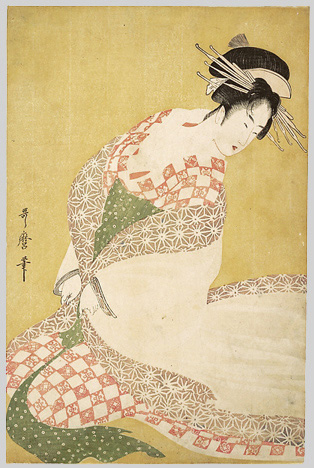
The outer robe
ca. 1795 - 38,1 x 24,8 cm - Colour woodcut
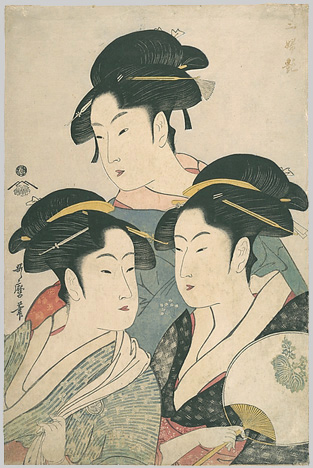
Three beauties of today
ca. 1791 - 38,7 x 25,7 cm - Colour woodcut with mica dust
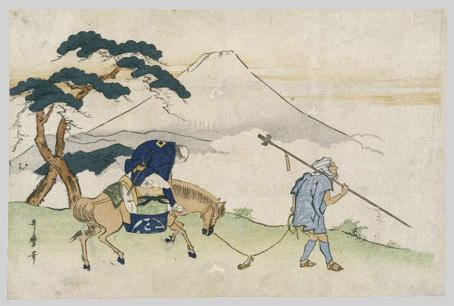
Travellers in front of Mount Fuji
ca. 1800 - 25,5 cm x 38,6 cm - Colour woodcut
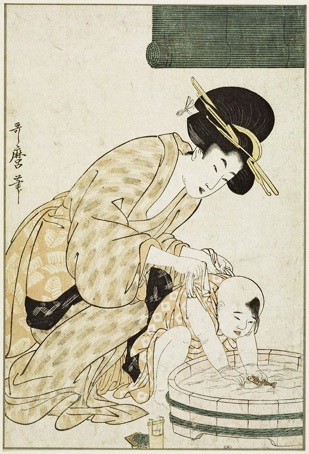
Playing in the water
ca. 1802 - 35,3 x 24 cm - Colour woodcut
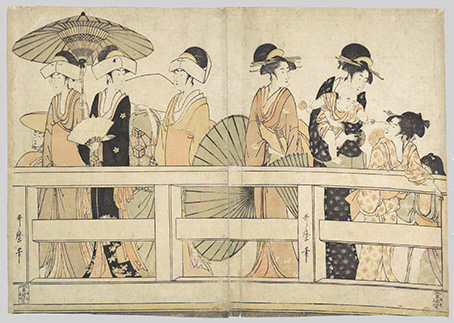
They enjoy the evening breeze on and under the bridge
ca. 1800 - 36,2 x 51,1 cm - Two leaves of a book with colour woodcuts
Katsushika Hokusai
葛飾 北斎
* probably 31. 10. 1760 in Warigesui, Honjo, Edo; † 10. 5. 1849 in Henjōin, Shōten-chō, Asakusa
Katsushika Hokusai is also considered one of the greatest masters of the colour woodcut. The line was narrative, its precise guidance and the pastel-coloured execution capture landscapes and stories that impress with their liveliness. Landscapes, flowers and birds have become his trademark. His most famous work is the 'Great Wave at Kanagawa'. A painting that has probably also achieved a high degree of fame in Europe.
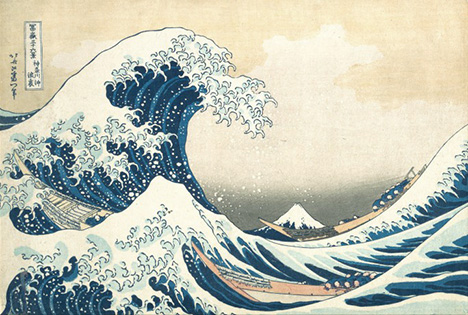
Under the wave off Kanagawa
From: 36 views of Mount Fuji
ca. 1830/32 - 26,5 × 38,1 cm - Colour woodcut
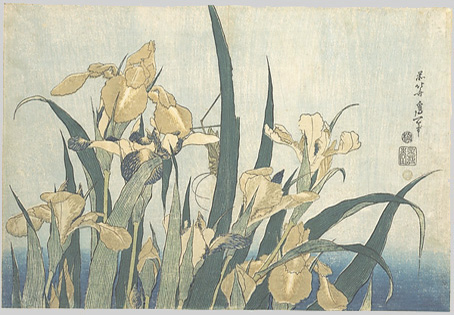
Irises and cicada
ca. 1820 - 24,8 x 36 cm - Colour woodcut and ink
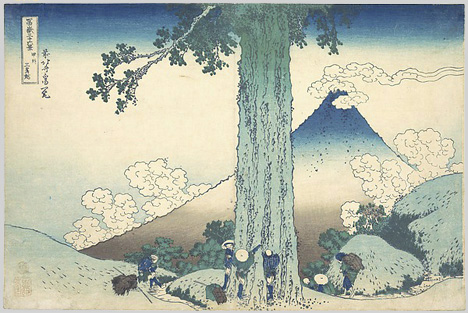
Mishima Pass in the province of Kai
from the series "Thirty-six views of Mount Fuji"
1830/32 - 24,8 x 37,5 cm - Colour woodcut and ink
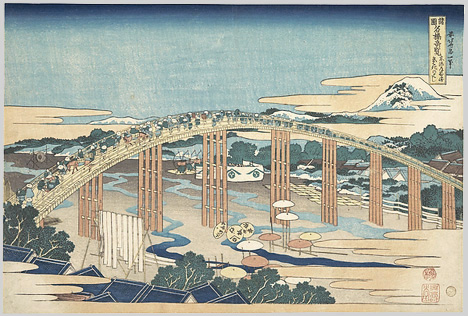
Yahagi Bridge near Okazaki
from the series "Remarkable bridges in the provinces"
1827/30 - 24,8 x 36,6 cm - Colour woodcut and ink
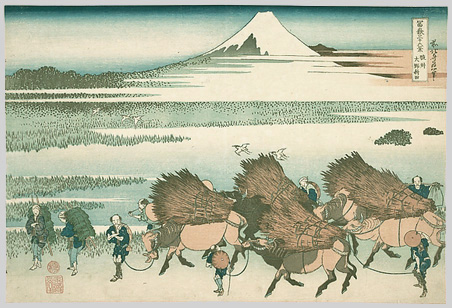
New fields near Aeno in the Suruga province
from the series "36 views of Mount Fuji"
1830/32 - 25,4 x 37,5 cm - Colour woodcut and ink
Utagawa Hiroshige
歌川 廣重
Utagawa Hiroshige is known for his atmospheric landscapes, which he combined in entire series of different perspectives, as in the 'Hundred Views of Edo'. He was a gentle interpreter of the landscape who came very close to the Japanese sense of a calm, balanced way of life. The pictures are full of atmosphere and man is a part of this nature; some works are reminiscent of paintings by Zen artists.
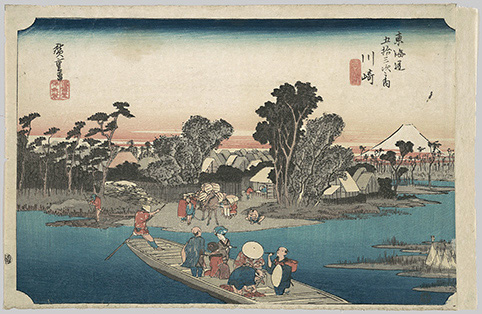
Ferry crosses the Rokugo River
ca. 1834 - 24,1 x 37,5 cm - Polychrome woodcut; ink and colour on paper
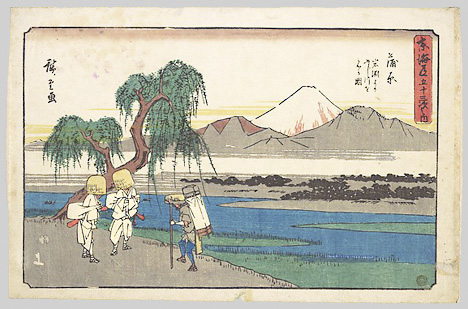
Kanbara: View of Mount Fuji from Iwafuchi
ca. 1842 - 22,5 x 34,3 cm - Colour woodcut
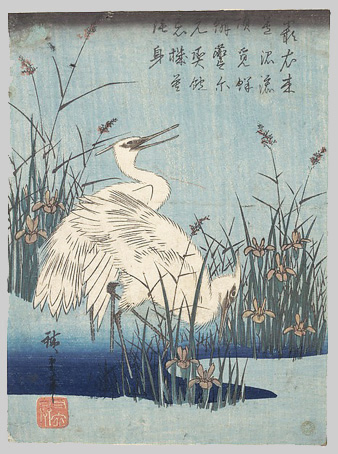
Great White Egret and Iris
ca. 1837 - 25,7 x 19,1 cm - Colour woodcut
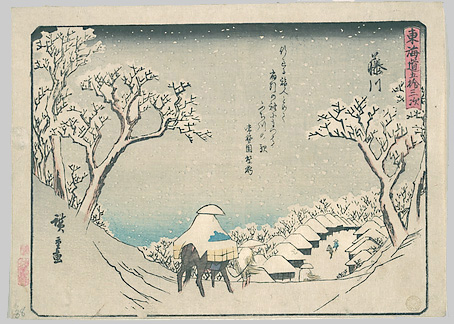
Fujikawa
from the series 'The Fifty-Three Stations of the Tôkaidô Road' (Tokaido Kyoka)
ca. 1838 - 23,2 x 17 cm - Colour woodcut
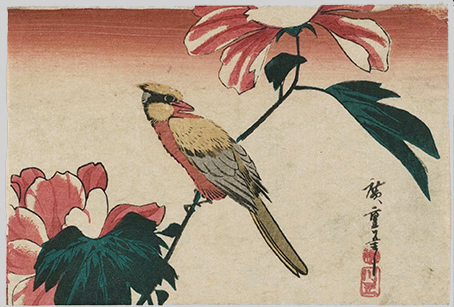
Hibiscus and jay
ca. 1840 - 11,1 x 16,5 cm - Colour woodcut
Around 1850, Japanese paintings, ceramics and screens became widely known in Europe. Woodcuts slowly became popular among artists. People became familiar with Japanese art. However, it took years before this art, which was considered exotic, was incorporated into the work of Europeans. Initially, Japanese works appeared in European paintings as 'decoration', but they did not change the style of painting. The composition remained traditionally European. A fine example of this is a painting by Manet: a portrait of Zola in which Japanese motifs can be seen in the background.
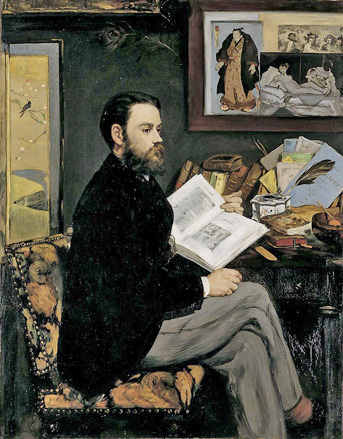
Édouard Manet: Portrait Émile François Zola
1868 - 146 x 114 cm - Oil on canvas
Musée d'Orsay, Paris, France >
Under the influence of Japanese woodcuts, Mary Cassatt created several works in this style around 1890:
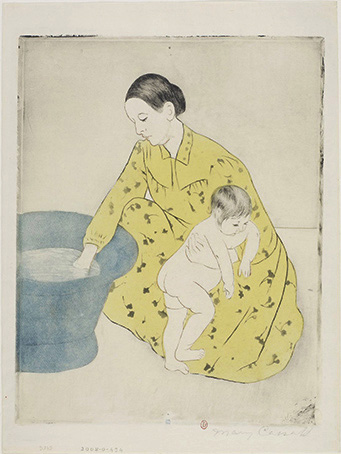
Mary Cassatt - Bath
ca. 1891 - 31,9 x 25 cm - Drypoint and aquatint in colour
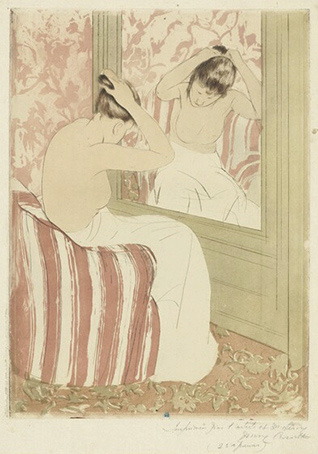
Mary Cassatt - Coiffure
ca. 1890/91 - 36,5 x 26,8 cm - Drypoint and aquatint in colour
Van Gogh also painted a self-portrait with a slightly altered Japanese painting from his collection in the background:
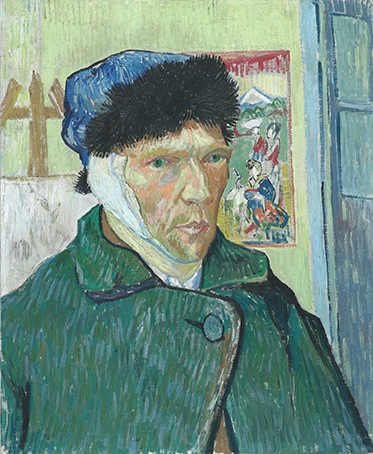
Vincent van Gogh: Self-portrait with bandaged ear
1889 - 50 x 60 cm - Oil on canvas
Courtauld Institute of Art, London, United Kingdom >
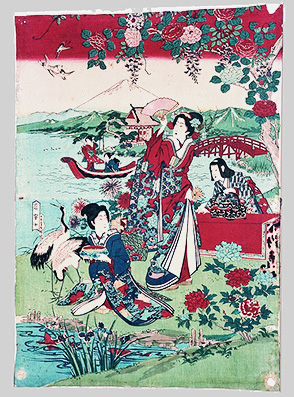
Torakiyo, Sato (Publisher) - Geishas in a landscape
19 x 32 cm
Woodcut in the background of the self-portrait formerly owned by Vincent van Gogh
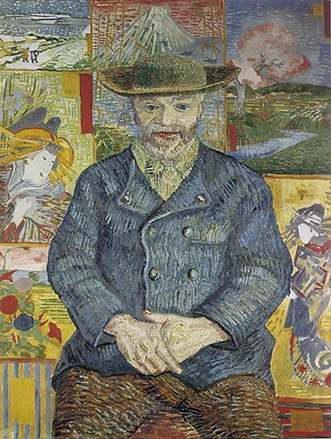
Portrait Père Tanguy
1887 - 92 x 75 cm - Oil on canvas
Musée Rodin, Paris, France >
Some of the countless Japanese prints in bright colours are placed in the background, that the artist collected together with his brother Theo, including the image of the courtesan by Keisai Eisen, which he also used in one of his own paintings.
While Japanese motifs had previously only been inserted, the perspective changed with van Gogh and Mary Cassatt. Van Gogh was intensively occupied with the 'images of the cheerful, transient world', the ukiyo-e. Like many other artists, he also owned several sheets of Japanese woodcuts. However, he was the first to go one step further: in three 'Japonaiseries', van Gogh attempted not only to adopt the Japanese model in form, but also to appropriate its spirit. On the one hand, the composition is devoid of the illusionistic depth seen in Europe; the colour becomes more planar. Another important characteristic is the different conception and division of space. There are still traces on paper, which then led to paintings that deepened his understanding of the Japanese concept of art.
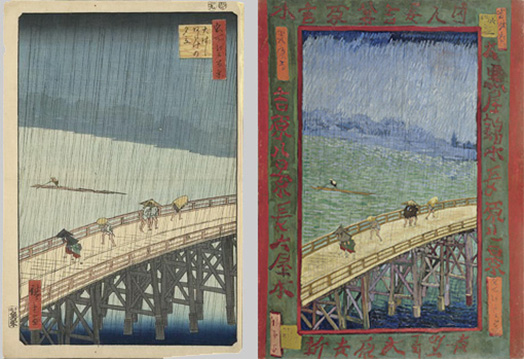
Utagawa Hiroshige – Sudden downpour over the Shin-Ōhashi Bridge and Atake
1857 - 34 x 24,1 cm - Woodcut
Vincent van Gogh – Japonoiserie: The bridge
1887 - 73 x 54 - Oil on canvas
Van Gogh Museum, Amsterdam, Netherlands >
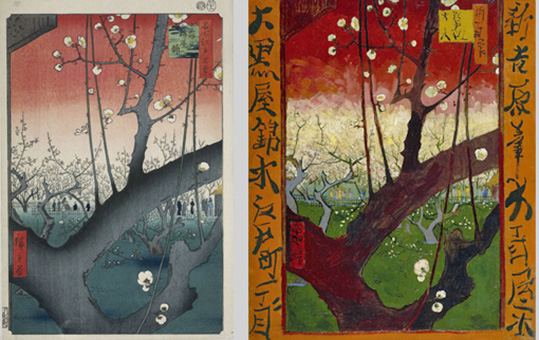
Utagawa Hiroshige – Plum park in Kameido
1857 - 37 x 25 cm - Woodcut
Vincent van Gogh –Japonoiserie: Blooming plum
1887 - 56 x 47 cm - Oil on canvas
Van Gogh Museum, Amsterdam, Netherlands >
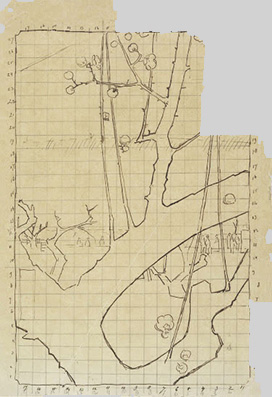
Vincent van Gogh - Preliminary drawing for plum tree
1887 - 38,3 x 26,2 cm - Pencil, pen and ink on paper
Van Gogh Museum Amsterdam, Netherlands >
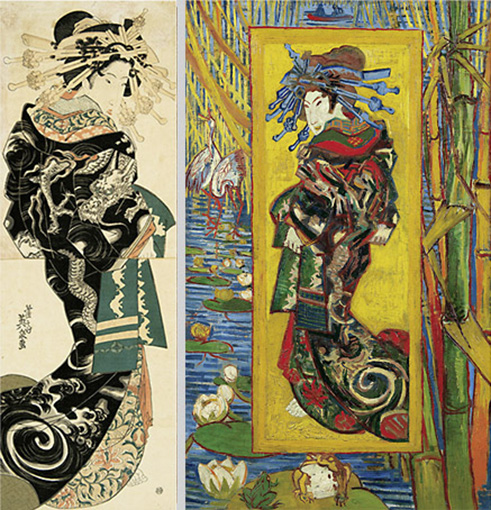
Keisai Eisen (1790 - 1848) - Courtesan
ca.
1840 - 70 x 24,7 cm - Colour woodcut on Japanese paper
Van Gogh Museum, Amsterdam
Vincent van Gogh - Courtesan (after Eisen)
1887 - 100 x 60 cm - Oil on canvas
Van Gogh Museum, Amsterdam, Netherlands >
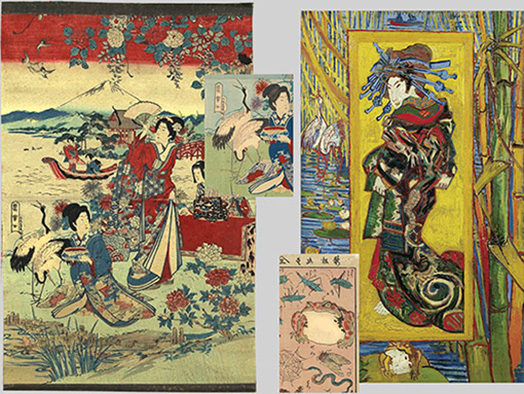
Further quotations can also be found on the edge of van Gogh's painting.
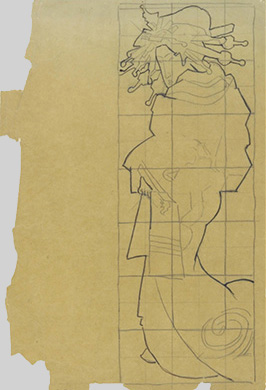
Sketch from the cover of the magazine Paris Illustré. Le Japon in May 1886
Vincent van Gogh
1887 - 39,4 × 26,3 cm
Van Gogh's preoccupation with Japonism had a strong influence on his own style of painting, which led him to develop further away from his role models from Barbizon and the Impressionists. Van Gogh's works also marked a decisive turning point in European art: from then on, artists used a wide variety of artworks from all over the world (not just Japan) in their work and processed the impressions and influences. It fundamentally changed artistic work.
Japanese art was presented as a highlight at the Paris World Exhibition in 1878. Of course, this also had an impact on the work of European artists, who had already taken up and processed the new ideas.
In addition to ceramics, items of clothing such as kimonos and garments from Japanese theatre were shown at the exhibition. The richly coloured fabrics and the sumptuously "Japanoise" dressed people were also the subject of paintings and woodcuts. Here are a few examples from the period from 1865 onwards that became famous in Europe.
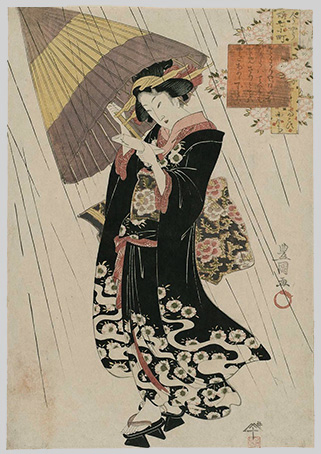
Utagawa Toyoshige: The poet Ono-no Komachi in the rain
ca. 1800 - 39 x 25 cm - Colour woodcut
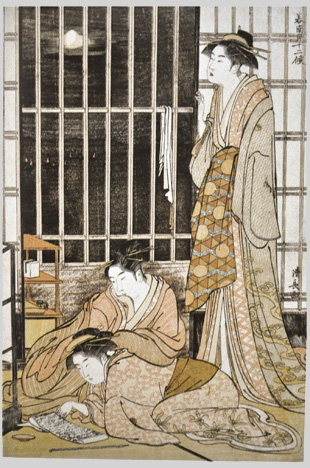
Torii Kiyonaga: The ninth month
1784 - 37,9 x 25,4 cm - Colour woodcut
Not only colour woodcuts came to Europe, but also ceramics and items of clothing, such as kimonos.
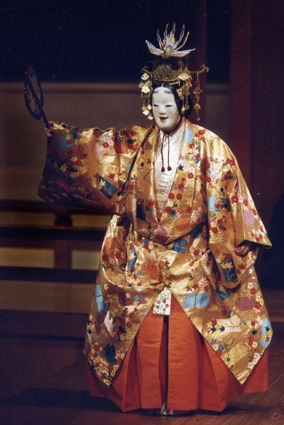
Actors dressed for a theatre play
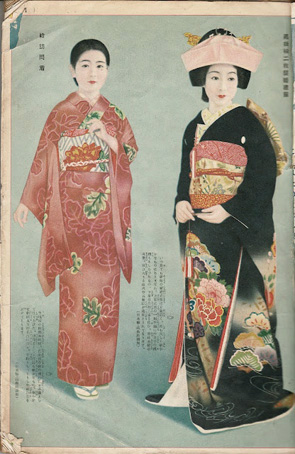
And the European processing:
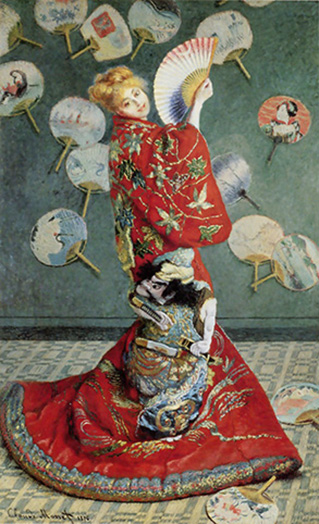
Claude Monet - La Japonaise, Madame Monet en costume japonais
1876 - 232 x 142 cm - Oil on canvas
Museum of Fine Arts Boston, USA >
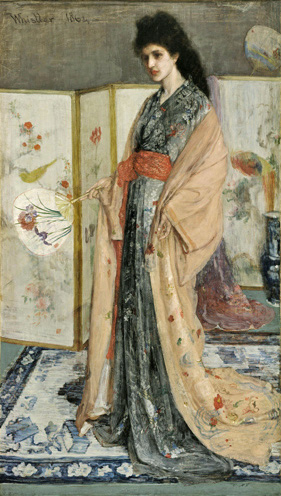
James McNeill-Whistler: La Princesse du pays de la porcelaine
1863/65 - 201 x 116 cm - Oil on canvas
National Museum of Asian Art, Smithsonian Institution, Washington, USA >
The influence clearly extended to Art Nouveau, as can be seen in the following picture:
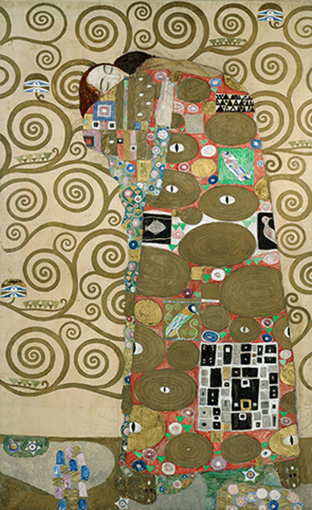
Gustav Klimt - Design for the wall frieze in the Palais Stoclet in Brussels
Detail: Part 8, Fulfillment
1905/09 - 194 x 120 cm - Gouache on cardboard
MAK (Museum of Applied Arts), Wien, Austria >
Another example in which the influence of Japanese painting can be seen in the division of the picture and the free surfaces:
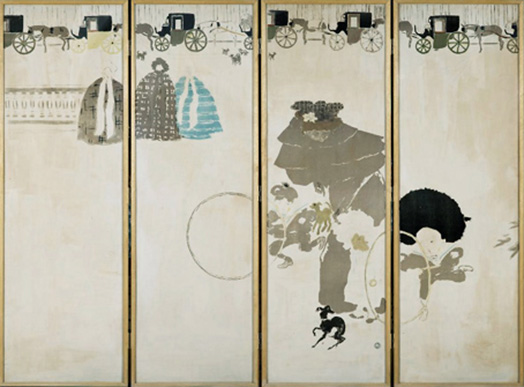
Pierre Bonnard - Promenade des nourrices, frise des fiacres
Screen: Walk of the nurses, Paravent
1894/1897 - je 143 x 46 cm - four lithographs in five colours
Museum d'Orsay and l'Orangerie, Paris, France >
Emil Orlik, a Bohemian painter and graphic artist, travelled to East Asia, including Japan, between 1900 and 1901. He brought back a wealth of prints that dealt with the themes of Japanese painting and its style.
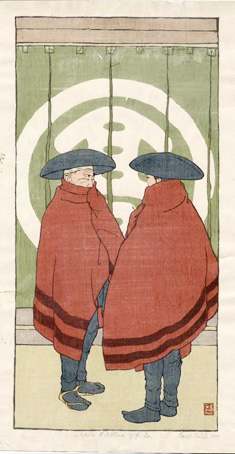
Emil Orlik - Ricksha driver, Japan
1900 - 31,7 x 15,8 cm - Woodcut
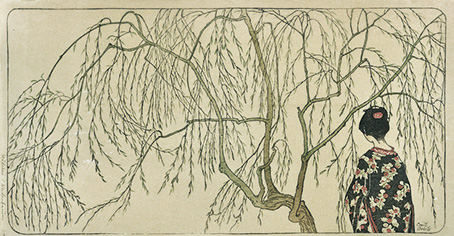
Emil Orlik - Japanese girl under the willow tree
1901 - 18,5 x 35,9 cm - Colour woodcut on Japanese paper
Gustave Courbet was inspired by the woodcut 'Under the Wave off Kanagawa' by Hokusai and painted a number of very similar wave paintings. A simple sea wave was previously unthinkable as a motif. Long before Monet, he painted an entire series of the same motif.
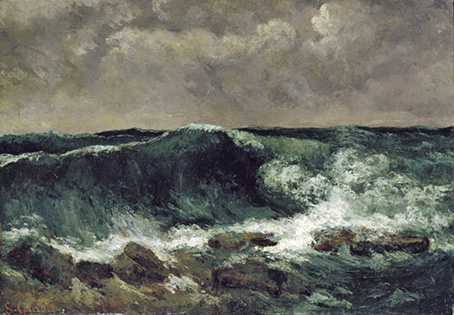
Gustave Courbet - The wave
1869 - 63 x 91 cm - Oil on canvas
Museum Städel, Frankfurt am Main, Germany >
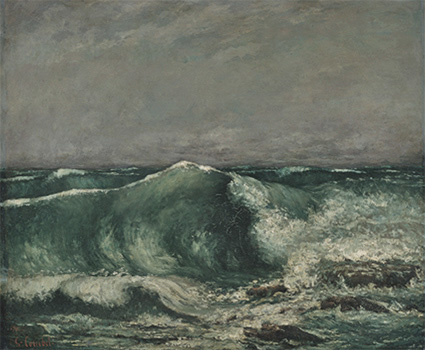
Gustave Courbet - The wave
1870 - 80 x 99 cm - Oil on canvas
Sammlung Oskar Reinhart «Am Römerholz», Winterthu, Suisser >
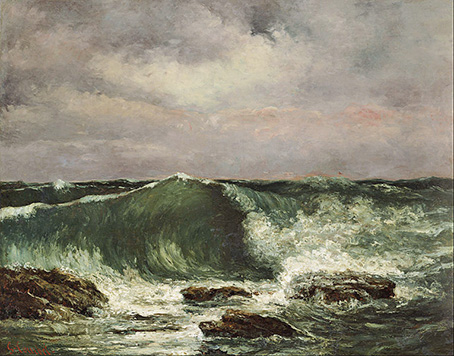
Gustave Courbet - Ocean wave
ca. 1870 - 72 x 92 cm - Oil on canvas
National Museum of Western Art, Tokyo, Japan >
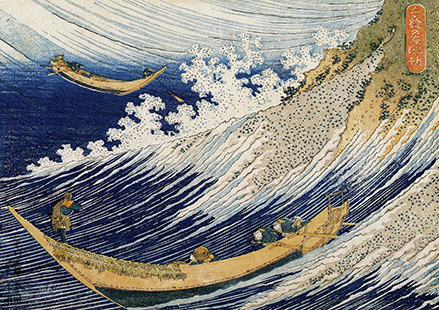
Katsushika Hokusai - Chōshi Shimosha
(from the series 'A Thousand Pictures of the Ocean')
1833 - 18,7 x 25,7 cm - Coloured wood stitch
Ingres / Delacroix |
Gustave Courbet |
|
|---|---|---|
Imprint |